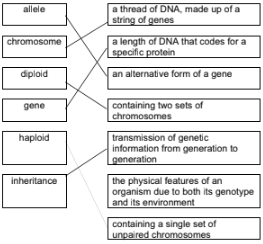Question
A DNA molecule has two strands as shown in Fig. 6.1.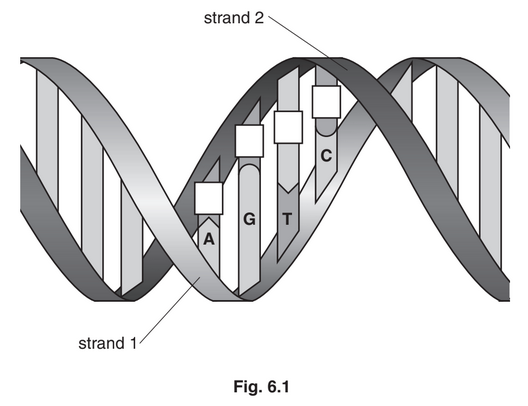
(a) (i) Fill in the boxes on Fig. 6.1 to show the letter of the bases on strand 2 that will pair with
the corresponding bases on strand 1. [2]
(ii) State the name for the structure of a DNA molecule as shown in Fig. 6.1.
………………………………………………………………………………………………………………………[1]
When molecules of DNA are used to classify species, only one of the two DNA strands is
sequenced.
First the DNA sequence from one strand of a DNA molecule from each species is lined up against
one strand from another species.
The bases of the DNA sequences from the same strand can then be compared with each other.
Fig. 6.2 shows a short section from the DNA sequences of eight plant species. There are ten
differences between species A and species B. These differences are shown in Fig. 6.2.
Species A: CTCCTCGGGT GACGGCCTAG CCCGTTGACG AATCCCATTC CTAAACTTT
Species B: CTCCTAGGGT GCAGGACTAG CCCGTTGACG AATCCCATTC CCAAGA
Species C: CTCATAGGGT GCAGGCCTAG CCCGTTGACG AATCACATTC CGATT
Species D: CTCATAGGGT GCAGGCCTAG CCCCTTGACG AATCCAATTC CGCTT
Species E: CTCATAGGGT GCAGGCCTAG CCCGTTGACG AATCCAATTC CGCTT
Species F: CTCCTAGGTT GCAGGCCTAG CCCTTTGAAG AATCACATTC CCCAA
Species G: CTCCTCGGGT GCAGGCATAG CCCTTTGACG AATCCCCTTC CGAAA
Species H: CTCCTAGGGT GCAGGCATAG CCCTTTGACG AATCCCCTTC CAAAAT
Fig. 6.2
(b) The number of differences between the DNA sequences of the eight species shown in Fig. 6.2
are recorded in Table 6.1.
Count the number of differences between the DNA sequences shown in Fig. 6.2 for:
• species C and species D
• species G and species H
Write your answers in Table 6.1.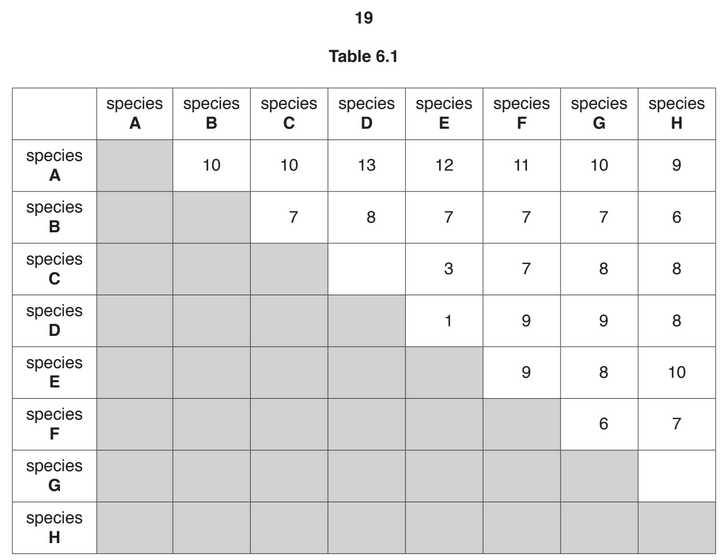
(c) The most closely related species have the fewest differences between their DNA sequences.
State which two plant species shown in Table 6.1 are most distantly related to each other.
……………………………………………………………………………………………………………………………..[1]
(d) The most closely related species have the shortest distance from a branching point on a
classification tree.
Use the information in Table 6.1 to complete the classification tree in Fig. 6.3. Write the
letter corresponding to species B, C, D and G in the box next to the correct branch of the
classification tree.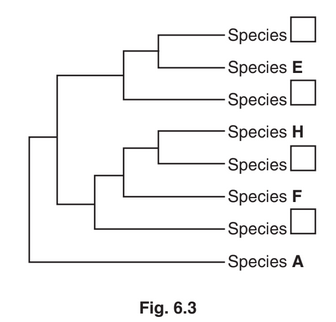
(e) A modern method for improving crop productivity is to cut out sections of DNA carrying a
useful gene from one organism and place them into another organism.
(i) Name the technique of inserting genes from one organism into another.
………………………………………………………………………………………………………………………[1]
(ii) A gene for producing a vaccine has been inserted into banana plants.
Give two other examples in which crop plants have been changed by inserting genes.
State one advantage for each example.
example 1 …………………………………………………………………………………………………………..
advantage ………………………………………………………………………………………………………….
………………………………………………………………………………………………………………………….
example 2 …………………………………………………………………………………………………………..
advantage ………………………………………………………………………………………………………….
………………………………………………………………………………………………………………………….
Answer/Explanation
Ans: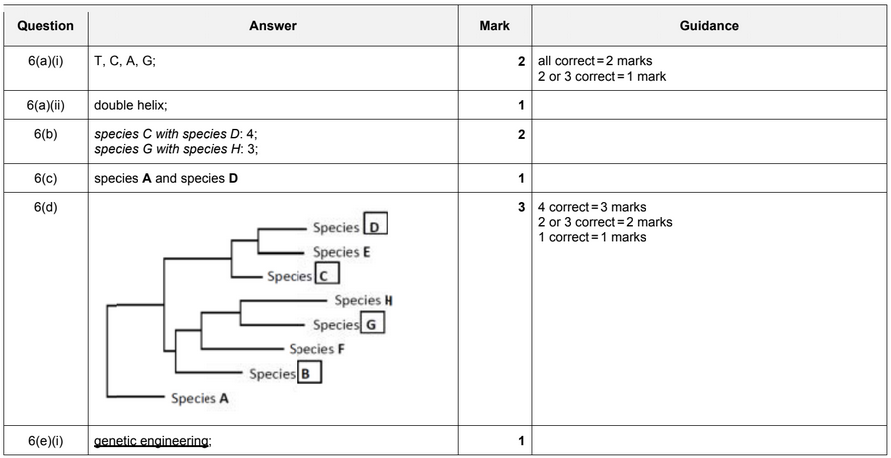
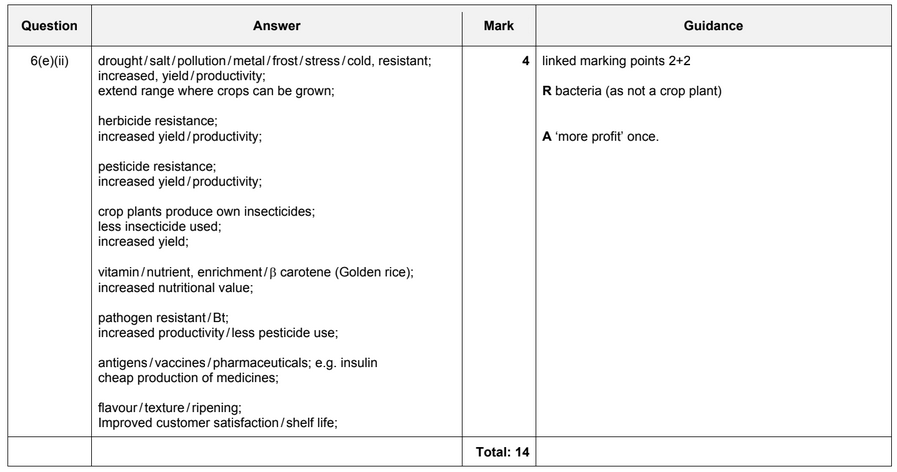
Question
Complete the sentences about the contents of a nucleus by writing the most appropriate
word in each space.
Use only words from the box.
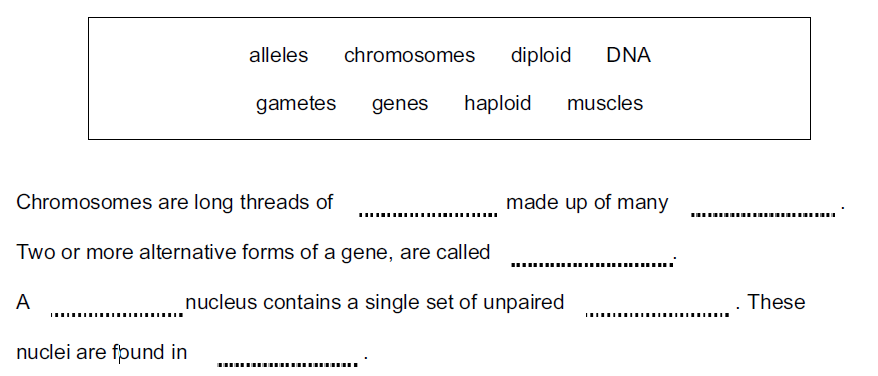
Answer/Explanation
Ans:

Question
The boxes on the left contain some genetic terms.
The boxes on the right contain definitions of genetic terms.
Draw one straight line to join each term to its correct definition.
Draw only five lines.
One example has been done for you.
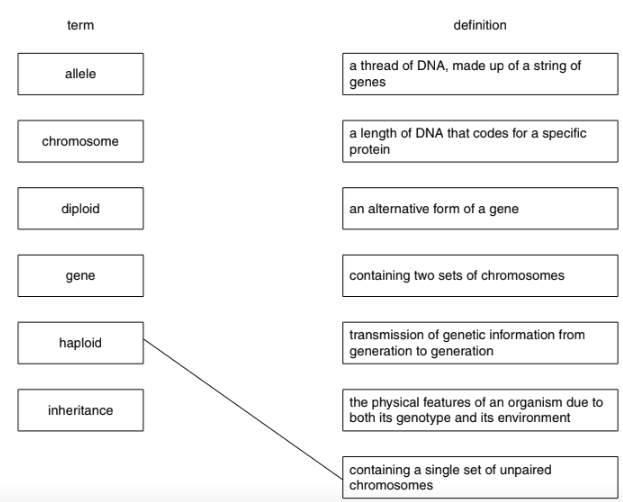
Answer/Explanation
Ans:
